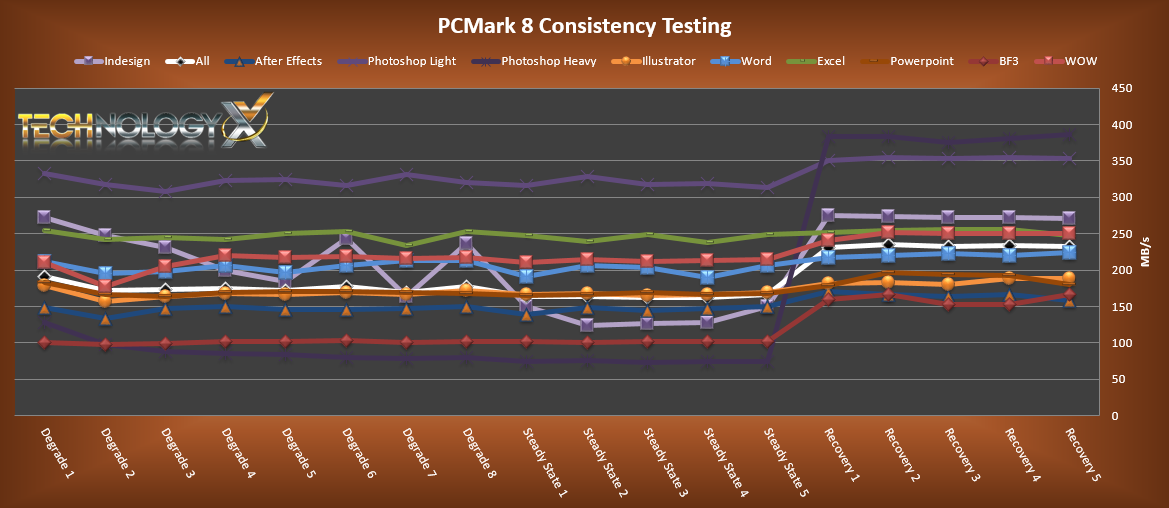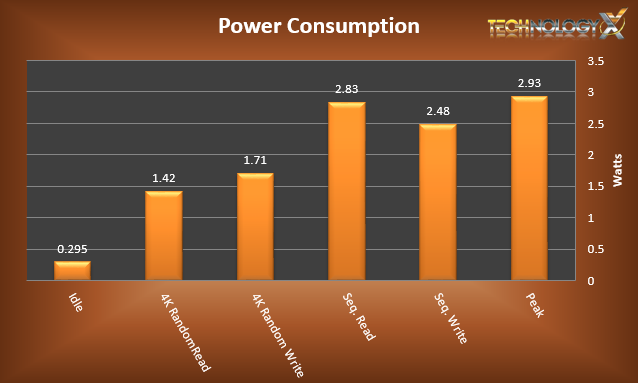The SSD Review uses benchmark software called PCMark Vantage x64 HDD Suite to create testing scenarios that might be used in the typical user experience. There are eight tests in all and the tests performed record the speed of data movement in MB/s to which they are then given a numerical score after all of the tests are complete. The simulations are as follows:
- Windows Defender In Use
- Streaming Data from storage in games such as Alan Wake which allows for massive worlds and riveting non-stop action
- Importing digital photos into Windows Photo Gallery
- Starting the Vista Operating System
- Home Video editing with Movie Maker which can be very time consuming
- Media Center which can handle video recording, time shifting and streaming from Windows media center to an extender such as XBox
- Cataloging a music library
- Starting applications
SAMSUNG 850 PRO PCMARK VANTAGE RESULTS
The Samsung 850 Pro 128GB SSD achieved a Total Score of 83,753 points with a high transfer speed of 479MB/s when testing importing pictures to Windows Media Center. The ‘Application Loading’ benchmark results only seem to reach around 248MB/s mark. For this new Pro denoted drive, we expected to see all speeds within the SATA 3Gb/s threshold, but it is still a 128GB drive in the end. Moving on, this drive is the highest scoring SSD we have tested with PCMark Vantage to date!
PCMARK 8 EXTENDED STORAGE WORKLOAD CONSISTENCY TESTING
For our last benchmark, we have decided to use PCMark 8 Extended Storage Workload in order to determine steady state throughput of the Samsung 850 Pro. This software is the longest in our battery of tests and takes just under 18 hours per SSD. As this is a specialized component of PCMark 8 Professional, its final result is void of any colorful graphs or charts typical of the normal online results and deciphering the resulting excel file into an easily understood result takes several more hours.
There are 18 phases of testing throughout the entire run, 8 runs of the Degradation Phase, 5 runs of the Steady State Phase and 5 runs of the Recovery Phase. In each phase, several performance tests are run of 10 different software programs; Adobe After Effects, Illustrator, InDesign, Photoshop Heavy and Photoshop Light, Microsoft Excel, PowerPoint and Word, as well as Battlefield 3 and World of Warcraft to cover the gaming element.
- PRECONDITIONING -The entire SSD is filled twice sequentially with random data of a 128KB file size. The second run accounts for overprovisioning that would have escaped the first;
- DEGRADATION PHASE – The SSD is hit with random writes of between 4KB and 1MB for 10 minutes and then a single pass performance test is done of each application. The cycle is repeated 8 times, and with each time, the duration of random writes increases by 5 minutes;
- STEADY STATE PHASE – The drive is hit with random writes of between 4KB and 1MB for 45 minutes before each application is put through a performance test. This process is repeated 5 times;
- RECOVERY PHASE – The SSD is allowed to idle for 5 minutes before and between performance tests of all applications. This is repeated 5 times which accounts for garbage collection; and
- CLEANUP – The entire SSD is written with zero data at a write size of 128KB
This is the first time we have been able to provide full consistency testing on a SSD with PCMark 8. We have to keep our eye on the ball that is the 850 Pro is meant for consumer use. There is no over provisioning that would assist a great deal in these tests specifically. With this in mind, PCMark 8 Extended Storage Testing is perhaps an unfair animal to throw at the 850 Pro, yet we still see very good results.
What mainly jumps out, right away, are the low Photoshop Heavy test results. Only averaging around 80-90MB/s in the degraded and steady states, they quickly jums up once TRIM and garbage collection have kicked in during the recovery phase. By far the best result comes from the Photoshop light workload averaging around the 300-325MB/s range. Maybe this will be a trend in later tests with other SSDs. Overall the 850 Pro averages just above 150MB/s for our consistency test. Up until recently most consumer drives did very poor in this aspect reaching low results of just around 30-50MB/s. To see this type of improvement is a good sign of where drives are heading and will ensure consumers a faster overall experience.
To see a chart comparison of the Samsung 850 Pro 1TB vs the SanDisk Extreme Pro 256GB, check our detailed analysis at TheSSDReview.
POWER CONSUMPTION
For our power consumption testing, we have the drive connected to the system as a secondary drive. To record the wattage, we use an Amprobe AM-270 multimeter connected in line with the 5v power on our SATA power cable to the drive. The multimeter records the min/max amperage draw from the drive over our testing period. We also record the drive’s sequential and random read and write power draw using Anvil Storage Utilities. We then take the values recorded and calculate the wattage of the drive. We are currently not able to provide an average power draw or record DEVSLP values of supporting drives, but we are working on it. Some of the results may seem high compared to a standard notebook HDD because as these are peak values under load. When we see average power draw, SSDs are still more power efficient because they only hit max power for a short period of time.
Specified power draw is as follows: Active Read (Average): Max. 3.3W(1TB), Active Write (Average): Max. 3.0W(1TB), Idle: Max. 0.4W, Device Sleep: 2mW
The Samsung 850 Pro SSD shows very good power consumption and results are well below the 1TB model as it does have less NAND packages. Idle power consumption is very low as with other Samsung SSDs reaching only 0.295 watts. In comparison, the Crucial MX100 uses about 1 watt during idle. During load the Samsung 850 Pro SSD reaches a peak of 2.93 watts. Most workloads, on the other hand, will cause the drive to draw around 2 watts on average I’d say after monitoring it over the course of testing.
Review Overview
Build
Performance
Consistency
Features
SSD Warranty
The Frist Consumer VNAND SSD!
The Samsung 850 Pro is the highest performing SATA 6Gb/s SSD we have reviewed to date. Packed with new innovative 3D V-NAND, full encryption support, and backed by an industry leading 10 year warranty, it is definitely worth a look!
 Technology X Tomorrow's Technology Today!
Technology X Tomorrow's Technology Today!




Do you feel like this is a game changer as far as SSD’s go? or just a good alternative to buying the Samsung 840 pro(which I own) ?
Well, performance has only slightly been improved, not enough to really be perceivable compared to your own 840 Pro. We don’t have any consistency tests of the old pro so we can’t direct compare for you yet. But the 10 year warranty, endurance increase, and the new V-NAND are definitely game changers.
Yeah I had a feeling that was going to be the case with the SSD, so if you do not already have an SSD and looking for a top of the line product in the consumer product then the 850 pro is a very good way to go. I remember with the EVO cam out with the RAPID technology and how pumped some enthusiasts were about the idea. I also remember that you mentioned it would eventually be able to be used by a 840 pro model, and one day while updating my firmware, it said Rapid available for these models and I was pretty excited. Especially because their is not just benchmark differences but also real world difference. Do you know if this SSD will have access to something similar? or maybe another a in the 850 line will. Thanks for the reply and keep writing man, I’ll keep reading.